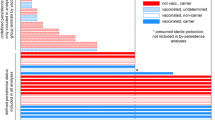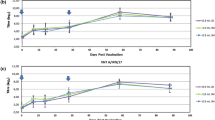Summary
The immunosuppressive effect of naturally acquired trypanosomiasis was investigated in four groups of zebu cattle maintained in an area of high tsetse fly challenge in Western Ethiopia. Two of the groups remained without chemoprophylaxis against trypanosomiasis and became parasitaemic. The animals of one of these two groups received a polyvalent foot-and-mouth disease vaccine and the cattle of the other group received foot-and-mouth disease vaccine together with a polyvalent clostridial vaccine. The cattle of the remaining two groups, regarded as controls, received fortnightly treatment with Berenil and remained free of trypanosomiasis; of these one group received foot-and-mouth disease vaccine alone and the other both foot-and-mouth disease vaccine and the clostridial vaccine.
Additionally two groups of cattle, one experimentally infected with trypanosomiasis and the other uninfected were also studied in a tsetse-free area. Each group received both foot-and-mouth disease and clostridial vaccines.
In all animals two doses of each vaccine were administered 21 days apart and the resulting antibody titres measured 10 days after the second vaccination.
It was found that there was a considerable depression in the titres to both vaccines in the trypanosome infected cattle relative to the controls, the differences being most marked in animals receiving both vaccines. However almost all titres were above those considered necessary to give more than 95 per cent protection to foot-and-mouth disease challenge by 10 days post second vaccination, and those of clostridial anti-toxin above the level generally considered to be protective.
It was concluded that despite the evidence of distinct immunosuppression in cattle from trypanosome endemic areas it was unlikely to impede the development of protection against foot-and-mouth disease and clostridial infection by vaccination.
Résumé
L'étude de l'effet immunosuppressif de la trypanosomose naturelle a été faite, en Ethiopie occidentale, chez quatre groupes de zébus maintenus dans une région hautement infestée de tsé-tsé. Les animaux de deux de ces groupes, élevés sans aucune protection chimioprophylactique, ont été parasités.
Les animaux de l'un de ces deux groupes ont reçu du vaccin polyvalent contre la fièvre aphteuse et ceux de l'autre groupe ont reçu le même vaccin ainsi qu'un vaccin polyvalent anti-clostridium.
Le bétail constituant les deux groupes restants utilisés comme témoins a été traité bi-mensuellement au Bérénil; il est demeuré indemne de trypanosomes. Les animaux de l'un de ces deux groupes témoins ont reçu du cavcin et du vaccin anti-clostridium.
En plus, deux autres groupes d'animaux, dont l'un expériementalement infecté de trypanosomes et l'autre non infecté ont été mis en observation dans une région sans glossines, chacun d'eux ayant reçu les deux vaccins en question.
Chex tous les animaux, deux doses de chaque vaccin ont été injectées à deux jours d'intervalle et les titres des anticorps ont été mesurés dix jours après la deuxième vaccination.
Un considérable abaissement dans les titres des anticorps spécifiques a été observé chez les animaux trypanosomés ayant reçu les deux vaccins par rapport aux animaux témoins, les différences étant les plus marquées chez les animaux ayant reçu à la fois les deux vaccins.
Quoiqu'il en soit, la presque totalité des titres observés ont été supérieurs à ceux considérés comme nécessaires pour donner plus de 95 p. 100 de protection contre la fièvre aphteuse, dix jours après la deuxième vaccination et ceux des anticorps contre le Charbon symptomatique ont été au dessus du niveau généralement considéré comme protecteur.
Il a été conclu de cette étude qu'en dépit de l'existence évidente de l'immunosuppression chez le bétail de régions à trypanosomose endémique, il est tout à fait improbable qu'elle puisse empêcher le développement de l'immunité vaccinale contre ces deux maladies.
Resumen
Se investigó el efecto inmunosupresivo de la tripanosomiasis natural en cuatro grupos de ganado Cebú, mantenidos en un área caracterizada por tener una población alta de mosca tsetse, en el Occidente de Etiopía. Dos de los grupos no recibieron tratamiento quimioprofiláctico y desarrollaron parasitemia. Los animales de uno de estos dos grupos fueron inoculados con una vacuna polivalente de aftosa, y los del otro grupo recibieron la vacuna de aftosa conjuntamente con otra polivalente de clostridio. El ganado de los grupos restantes considerados como controles, recibieron un tratamiento con Berenil cada 15 días, suficiente éste para prevenir el desarorllo de la enfermedad. De estos, un grupo fue vacuando contra aftosa únicamente y el otro recibió la vacuna de aftosa y clostridio conjuntamente.
Adicionalmente, dos grupos de ganado, uno infectado experimentalmente con tripanosomiasis y el otro libre de la enfermedad, fueron estudiados en un área libre de moscas tsetse. Ambos grupos recibieron la vacuna contra aftosa y clostridio.
En todos los animales se administraron dos dosis de cada vacuna, con 21 días de intervalo, midiéndose el nivel de anticuerpos resultantes 10 días después de la segunda vacunación.
Se encontró un fuerte descenso en el nivel de anticuerpos de ambas vacunas en el ganado infectado de tripanosomiasis, en comparación con los controles, siendo la diferencia más marcada en los animales que recibieron ambas vacunas. Sin embargo, el nivel de los títulos de anticuerpos, generados por la vacuna antiaftosa como los resultantes de la vacunación contra infecciones por clostridios, estuvieron por encima de las recomendados para obtener un 95% de proteccioón.
Se concluye, que a pesar de la inminosupresión evidente causada por la tripanosomiasis en ganados de áreas endémicas, ésta no interfiere con el desarrollo de la inmunidad conferida por las vacunas polivalentes de aftosa y clostridio.
Similar content being viewed by others
References
British Veterinary Codex (1965). Supplement (1970), p. 257. Pharmaceutical Press. London.
Goodwin, L. G. (1970).Transactions of the Royal Society of Tropical Medicine and Hygiene,64, 797.
Goodwin, L. G., Green, D. G., Guy, M. W. &Voller, A. (1973).British Journal of Experimental Pathology,53, 40–43.
Holmes, P. H., Mammo, E., Thomson, A., Knight, P. A., Lucken, R., Murray, P. K., Murray, M., Jennings, F. W. &Urquhart, G. M. (1974).Veterinary Record,95, 86–87.
Jennings, F. W., Murray, P. K., Murray, M. &Urquhart, G. M. (1973).Transactions of the Royal Society of Tropical Medicine and Hygiene,67, 277.
Mackenzie, P. K. I., Boyt, W. P., Emslie, W., Lander, K. P. &Swanepoel, R. (1975).Veterinary Record,97, 452–453.
Martin, W. B. &Chapman, W. G. (1961).Research in Veterinary Science,2, 53–61.
Pay, T. W. F. (1971).Proceedings of the Second International Congress of Virology, Budapest, 1971.
Pay, T. W. F. &Parker, M. J. (1977). Proceedings of International Association of Biological Standardisation; International Symposium of FMD. Lyon, 1976. (In press.)
Urquhart, G. M., Murray, M., Murray, P. K., Jennings, F. W. &Bate, Elma (1973).Transactions of the Royal Society of Tropical Medicine and Hygiene,67, 528–535.
Author information
Authors and Affiliations
Rights and permissions
About this article
Cite this article
Scott, J.M., Pegram, R.G., Holmes, P.H. et al. Immunosuppression in bovine trypanosomiasis: Field studies using foot-and-mouth disease vaccine and clostridial vaccine. Trop Anim Health Prod 9, 159–165 (1977). https://doi.org/10.1007/BF02236590
Accepted:
Issue Date:
DOI: https://doi.org/10.1007/BF02236590




